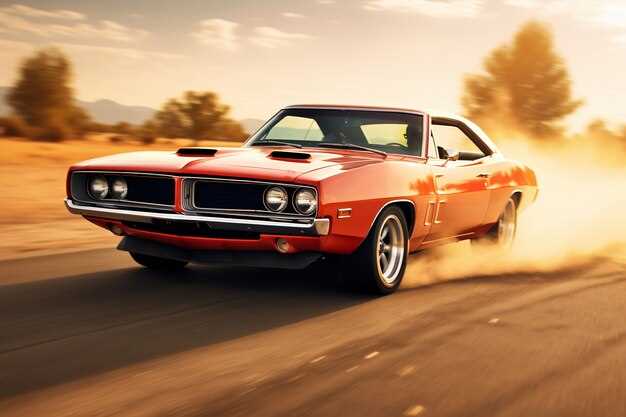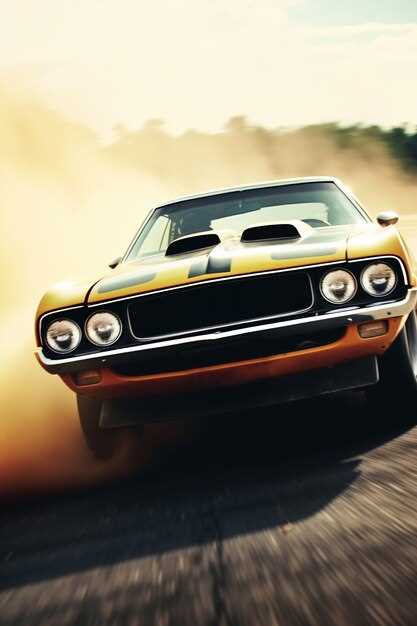If you’re searching for extraordinary muscle cars that stand out from the crowd, consider the Pontiac GTO Judge. This 1969 model introduced bold colors and decals alongside its powerful 400-cubic-inch V8 engine. Known for its performance and unique aesthetic, the Judge remains a sought-after classic, representing the pinnacle of muscle car culture.
Another remarkable choice is the Chrysler 300 Hurst. This 1970 variant, produced in limited numbers, combines luxury and speed. It features a potent 440-cubic-inch engine and distinctive Hurst styling, making it a rare gem for collectors. The fusion of elegance and brawn is evident in every detail, ensuring it stands out at car shows.
Don’t overlook the Oldsmobile 442, especially the 1970 version, which boasts a robust 455-cubic-inch engine. This muscle car delivers a unique blend of horsepower and refinement, often overshadowed by its contemporaries. The 442’s distinctive style and performance capabilities make it a fascinating option for any enthusiast.
Lastly, the Dodge Super Bee from 1968 deserves attention. Featuring a striking design and a fierce 426 Hemi or 440-cubic-inch engine, this car encapsulates the raw power associated with muscle cars. With fewer than expected units produced, the Super Bee is an exciting find for those interested in rare automotive history.
The Legends: Iconic Muscle Cars of the Past
The Pontiac GTO ignited the muscle car craze in the 1960s, combining a powerful V8 engine with a lightweight body. Known as the “GOAT,” it spurred competition among manufacturers and remains highly sought after by collectors.
The Ford Mustang, introduced in 1964, exemplified American automotive culture. From the original models to the fierce Shelby variants, Mustangs have maintained a legendary status with their distinctive style and performance abilities.
The Chevrolet Camaro, launched in 1966, quickly became a rival to the Mustang. Its aggressive aesthetics and range of engine options made it a favorite among speed enthusiasts. The Z28 version is particularly renowned for its track capabilities.
The Dodge Charger, especially the 1969 model, is iconic for its bold design and powerful engines. Featured in numerous films, it blends style with muscle, boasting an expansive V8 lineup that delights driving purists.
The Plymouth Barracuda, with its unique fastback design, was one of the earliest muscle cars. Its 426 Hemi engine option made it a formidable competitor on both the streets and the racetracks.
Lastly, the Buick GSX holds a special place among muscle car aficionados. With its rich heritage and impressive performance credentials, it proves that Buick was not just about luxury, but also about raw power.
These vehicles shaped the muscle car segment, each leaving an unforgettable mark on automotive history. Owning any of these models brings you a piece of that legacy.
Limited Editions: Rare Finds in Muscle Car History
One exceptional example of limited edition muscle cars is the 1970 Pontiac GTO Judge, with only 6,725 units produced. Its distinctive graphics and powerful 400-cubic-inch V8 engine make it a sought-after collector’s item. Find one in good condition, and you can expect a significant return on investment.
The 1969 Ford Mustang Boss 429 represents another rarity. Designed primarily for NASCAR homologation, only 1,359 units rolled off the assembly line. Its high-output 429 cubic inch engine and iconic styling attract enthusiasts and collectors alike.
Consider the 1971 Dodge Challenger R/T Hemi, featuring the legendary 426 Hemi engine. With fewer than 100 examples produced, it stands as one of the rarest muscle cars. Its aggressive design and raw power capture the essence of the muscle car era.
Another remarkable entry is the 2008 Dodge Challenger SRT8, which marked the return of the Challenger nameplate. Limited to just 6,400 units, it combined retro styling with modern performance, appealing to both new buyers and seasoned enthusiasts.
The 2010 Chevrolet Camaro SS 1LE pays homage to the original 1980s performance package. With only 1,000 units available, the combination of handling enhancements and performance parts makes it a unique find in the modern muscle car scene.
When searching for these limited editions, attending collector car auctions and joining exclusive clubs expands your opportunities to discover rare gems. Online marketplaces and forums also provide valuable leads, connecting buyers with sellers of these remarkable vehicles.
Collectibility Factors: What Makes a Muscle Car Valued?
The value of a muscle car hinges on several key factors. Here are the most significant elements to consider:
- Rarity: Limited production models attract collectors. Cars such as the 1970 Chevrolet Chevelle SS 454 are prized for their low production numbers.
- Originality: Unrestored or mostly original vehicles fetch higher prices. Documentation of original parts and factory specifications enhances desirability.
- Condition: A well-preserved muscle car commands attention. Cars graded at a higher level by organizations like the National Corvette Restorer’s Society (NCRS) often appreciate more rapidly.
- Performance: High-performance variants, equipped with powerful engines, draw interest. Models like the Ford Mustang Boss 429 exemplify this factor.
- Historical Significance: Cars tied to notable events or figures in automotive history increase in value. The Dodge Charger, known for its role in movies like “Bullitt,” symbolizes this appeal.
- Market Trends: Awareness of current collector interest shapes value. Keep an eye on auction results and typical sale prices for various makes and models.
- Customization: While original cars are often more valued, unique and tasteful modifications can enhance a car’s appeal to certain buyers.
Understanding these factors helps gauge the collectible potential of a muscle car. Research, networking, and engagement with fellow enthusiasts further inform decisions in building a valuable collection.
Modern Classics: Contemporary Muscle Cars That Stand Out
The Dodge Charger R/T combines bold styling with a powerful V8 engine, delivering an exhilarating driving experience. With up to 370 horsepower, it effortlessly balances performance and comfort.
The Ford Mustang GT takes performance to another level with its 5.0-liter V8 engine that produces 450 horsepower. Its sleek design and advanced technology, like the available MagneRide suspension, ensure a dynamic ride on any road.
The Chevrolet Camaro SS is a fierce competitor in the muscle car realm. Featuring a robust 6.2-liter V8 engine, it offers 455 horsepower along with a refined interior that elevates the driving experience. Its sharp handling makes it a favorite for enthusiasts.
For those seeking flair, the Chrysler 300 SRT impresses with its luxury and power. A 6.4-liter HEMI V8 engine delivers exhilarating performance while maintaining a lavish interior packed with modern amenities.
The Ford Mustang Mach 1 pays homage to its roots while incorporating modern engineering. With a high-performance 5.0-liter V8 and unique styling cues, it stands out as a modern classic that keeps the spirit of muscle cars alive.
Don’t overlook the Chevrolet Corvette Stingray. While often classified as a sports car, its V8 performance and aggressive design place it firmly in the conversation. The mid-engine layout enhances handling, making it a thrilling option for any car enthusiast.
In the world of muscle cars, these models represent a perfect blend of tradition and modernity. Each offers unique features that cater to various preferences, ensuring there’s a contemporary muscle car for everyone.
Restoration Tips: Keeping Your Rare Muscle Car in Top Shape
Prioritize preventive maintenance. Regular checks on fluids, brakes, and tires help catch issues before they escalate. Schedule routine oil changes and inspect your battery to avoid unexpected breakdowns.
Store your car properly. Use a climate-controlled garage to protect against humidity and temperature swings. Consider using a car cover to guard against dust and scratches. Ensure proper ventilation to prevent rust.
Use original parts when possible. Sourcing OEM components maintains authenticity and usually guarantees better fit and performance. Join car clubs and online forums to find reliable suppliers and fellow enthusiasts for tips.
Keep the paintwork pristine. Wash your car regularly using a pH-balanced soap. Wax it every few months to create a protective layer. For chips or scratches, use touch-up paint to maintain the exterior’s integrity.
Pay attention to the interior. Preserve upholstery by using seat covers and avoid prolonged sun exposure. Clean surfaces with appropriate products to avoid damage. Replace worn-out components promptly to keep the interior looking its best.
Document all restoration work. Maintain a detailed log that includes receipts, photos, and descriptions of the work performed. This adds value and can be a great resource for future repairs or restorations.
Drive it regularly. Taking your muscle car out for a spin prevents mechanical issues that arise from inactivity. It keeps seals lubricated and batteries charged, while also allowing you to enjoy the ride.
Consult experts when needed. If faced with complex repairs, don’t hesitate to seek out experienced mechanics familiar with muscle cars. Their expertise can save time and ensure quality work.
Joining the Community: Clubs and Events for Muscle Car Enthusiasts
Connect with fellow muscle car lovers by joining local and national clubs. The National Muscle Car Association (NMCA) offers events across the U.S., providing opportunities for racing and networking. Membership often includes access to exclusive discounts, events, and newsletters about muscle car news.
Consider the American Muscle Car Club, which organizes regular meet-ups and car shows. These gatherings create a relaxed atmosphere to share tips, exchange stories, and showcase your ride. Check their website for schedules and locations of upcoming events.
Car shows are a major highlight for the community. The Muscle Car and Corvette Nationals event in Rosemont, Illinois, attracts enthusiasts and showcases rare models. Make sure to register your vehicle to gain exposure and connect with potential buyers or fellow restorers.
Online communities like Facebook groups and forums offer an excellent platform for discussions and tips. Groups focused on specific brands or models provide targeted information and a support network. Engage actively to maximize your experience.
| Club/Event Name | Description | Location | Website |
|---|---|---|---|
| National Muscle Car Association (NMCA) | Racing events and networking opportunities | National | nmcadigital.com |
| American Muscle Car Club | Regular meet-ups and car shows | Various locations | americanmusclecarclub.com |
| Muscle Car and Corvette Nationals | Showcase of rare models | Rosemont, Illinois | mcacn.com |
Participating in these clubs and events enhances your muscle car experience. Share your passion and grow your network within this enthusiastic community.







